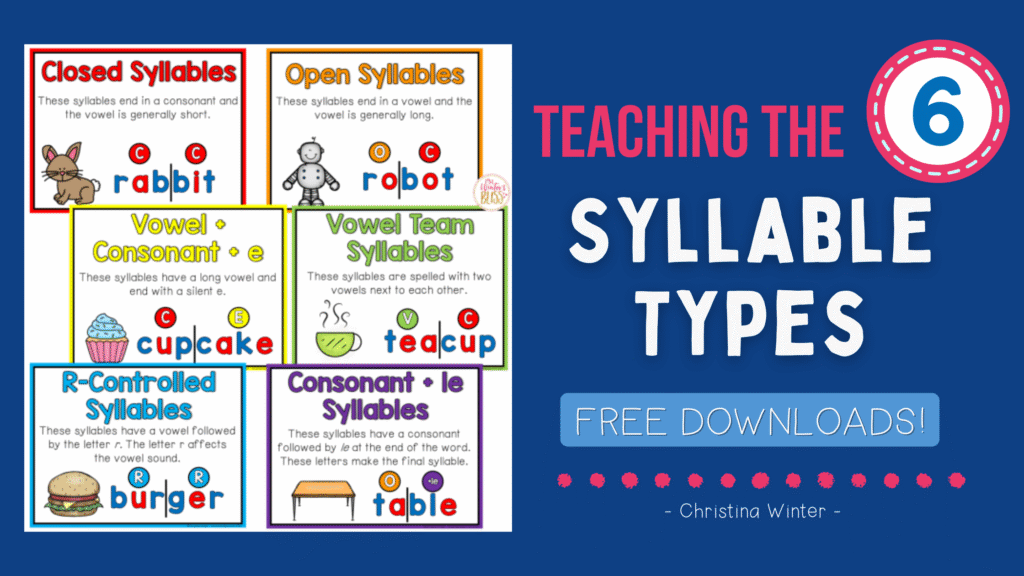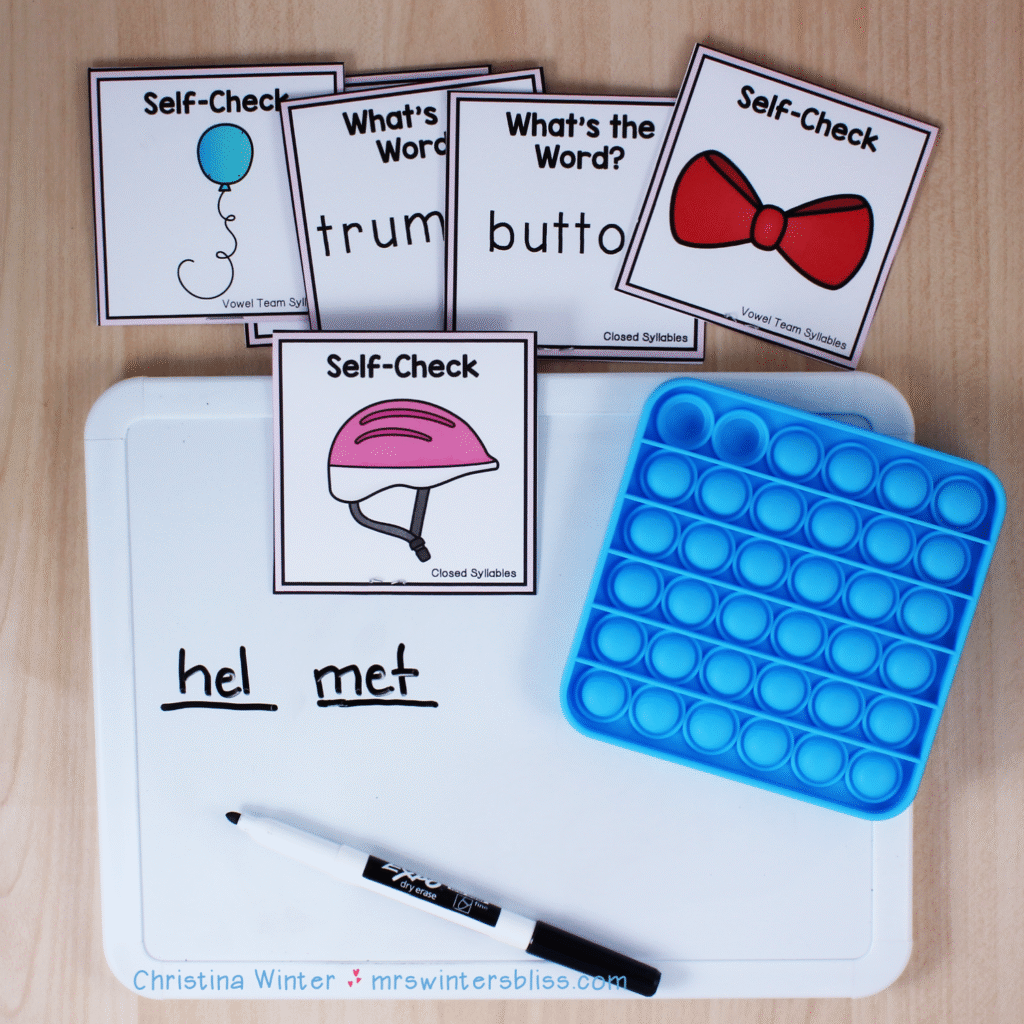In this post, you’ll discover the answer to commonly asked questions about the Six Syllable types including…
-What are the Six Syllable Types?
–How do the Six Syllable Types help students decode longer words?
–When should the syllable types be taught?
Be sure to grab the FREE syllable types teaching posters and activities you can begin using in your classroom today!
If you’ve ever watched a student guess their way through a longer word and just hope for the best, you’re not alone. I’ve been there. We’ve probably all seen it….a student who stares at a word like fantastic, takes a stab at the first syllable, and then kind of just mumbles the rest.
What can we do to help these students? They need more guessing strategies. They need explicit instruction for how to decode words.
Teaching the 6 syllable types gives students the information and tools need decode longer words with confidence.

Today I’m excited to dive into the six syllable types. I’ll explain what they are, when to teach them, why they work, and offer ideas for activities to make them stick. Be sure to grab my FREE syllable types posters and resource to help bring this important instructional practice into your classroom!
The 6 Syllable Types
Think of these as the building blocks of the English language. Once your students can recognize and name syllable types, they can use that knowledge to break apart multisyllabic words and actually read what’s on the page.
Here’s a quick guide to each syllable type:
? Closed Syllables (rab–bit) – The vowel is short, and the syllable ends in a consonant.
? Open Syllables (ro–bot) – The syllable ends in a vowel, and that vowel says its name (long sound).
? Vowel-Consonant-e (cup–cake) – A silent ‘e’ at the end makes the vowel long.
? Vowel Team (tea–cup) – Two vowels work together to make one sound.
? R-Controlled (bur–ger) – The “bossy r” changes the way the vowel sounds.
? Consonant + LE (ta–ble) – Found at the end of words; it’s the consonant plus -le.

? Download your FREE Syllable Types posters. They are perfect to put use as an anchor chart display or have on hand at your small group table.
When to Teach Each Syllable Type
Knowing what to teach is just the beginning. Let’s talk about when to teach each syllable type.
| Grade Level | Focus Syllable Types |
| Kindergarten | Closed (after mastering CVC words) |
| 1st Grade | Open, VCe, and simple Vowel Teams |
| 2nd Grade | R-Controlled and Consonant + LE |
Use your phonics scope & sequence as your guide. Keep it explicit and systematic. Each syllable type builds on the last. If your school does not provide you with an SoR-aligned phonics scope and sequence, grab a free one here.
Why Teach the Syllable Types
Students need an explicit strategy for breaking longer words into manageable parts. Without one they may become easily intimidated by longer words, guess at them or even skip them.
Familiarity with syllable-spelling conventions helps students know if a vowel is long, short, a diphthong, r-controlled, or whether endings have been added. Familiarity with syllable patterns helps students to read longer words accurately and fluently.
Ideas for Teaching the Syllables
Here’s the good news: you don’t need a whole new curriculum to teach syllable types well. Just a few simple routines and activities. Fortunately, there are a lot of options out there to choose from. Here are a few of my favoriites…
- Silicone Bubble Poppers: Students simply push down a popper for each syllable they hear in the given word. Then they identify the type of each syllable they “popped”.

2. Multisyllabic Words Manipulation: Divide words you’ve selected from upcoming reading selections into syllables. Write each syllable on a note card. Display the syllables that make up one of the words in jumbled order (e.g., tas fan tic). Have students arrange the syllables to form the word. When necessary, discuss the pronunciation and spelling generalizations of any confusing syllables.
3. Linking Cubes: Physical linking cubes allow students to see how longer words are just made up of smaller parts. Students use different colored cubes to represent the different syllable types. They can build each syllable and then link them together to form the full, longer word.
Syllable Types and Syllable Division Activities
This syllable types and syllable division resource comes with everything you need to teach your students how to attack longer words with confidence!

First, you’ll get digital teaching slides designed for explicit whole group instruction. These slides introduce students to each of the syllable types and allow you to explicitly model and practice together how to break words up and identify the type.

Next, you get small group practice activities to help your students master the six syllable types.
PRO TIP: Print the activities just once and use a sheet protector that students can write and erase as you lead them through the routine of identifying the vowels, number of syllables, and dividing the syllables of each word.

Students can get more independent practice using the interactive, NO PREP digital slide activities.

The syllable types printables provide students with independent practice decoding one syllable, two syllable, and three syllable words. They are perfect for independent practice, centers and small group instruction!

Finally, you’ll get teaching posters for each type of syllable that you can use for your direct instruction and/or post in your classroom so students can reference them when needed!

To get you started I’m sharing FREE Syllable Types and Syllable Division – Digital & Printable Activities! This sample makes a perfect Syllable Types literacy center or independent activity!

I hope the information and resources will help you bring more explicit syllable type instruction to your classroom. When you do, you are giving your students the confidence and skills to unlock the world of words.




